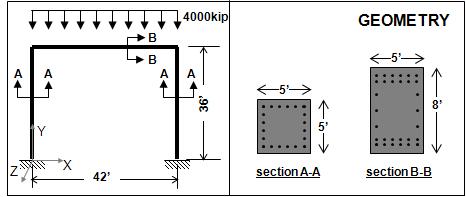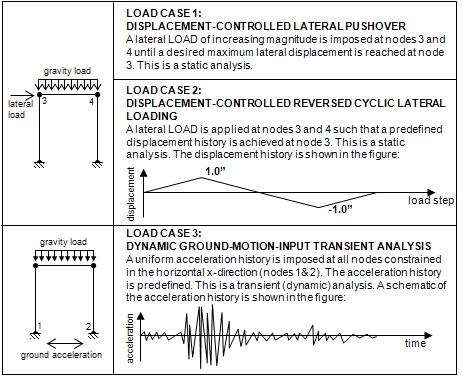Getting Started with OpenSees -- Problem Definition: Difference between revisions
Jump to navigation
Jump to search
(Created page with 'A portal frame will be used to demonstrate the OpenSees commands. A structural model will be defined first. Subsequently, a number of static and dynamic analyses will be defined …') |
No edit summary |
||
| (2 intermediate revisions by one other user not shown) | |||
| Line 1: | Line 1: | ||
{{GettingStartedManualMenu}} | |||
A portal frame will be used to demonstrate the OpenSees commands. A structural model will be defined first. Subsequently, a number of static and dynamic analyses will be defined and implemented. | A portal frame will be used to demonstrate the OpenSees commands. A structural model will be defined first. Subsequently, a number of static and dynamic analyses will be defined and implemented. | ||
The structural model consists of the planar portal frame shown in the figure below: | The structural model consists of the planar portal frame shown in the figure below: | ||
[[File:GettingStartedGeometry.JPG|link=Getting Started with OpenSees -- Problem Definition]] | |||
| Line 15: | Line 17: | ||
In all cases, however, the frame will be subjected to constant static gravity loads: | In all cases, however, the frame will be subjected to constant static gravity loads: | ||
[[File:GettingStartedLoading.JPG|link=Getting Started with OpenSees -- Problem Definition]] | |||
---- | ---- | ||
Return to [[Getting Started with OpenSees]] | Return to [[Getting Started with OpenSees]] | ||
Latest revision as of 22:14, 12 March 2010
- GettingStarted Manual
- Introduction
- Download OpenSees
- Run OpenSees
- Problem Definition
- Model Builder
- Nodes
- Elements
- Recorders
- Summary of Model-Building Input File
- Loads and Analysis
- Gravity Loads
- Summary of Gravity Loads
- Lateral Loads -- Static Pushover
- Lateral Loads -- Cyclic Lateral Load
- Lateral Loads -- Dynamic ground motion
A portal frame will be used to demonstrate the OpenSees commands. A structural model will be defined first. Subsequently, a number of static and dynamic analyses will be defined and implemented.
The structural model consists of the planar portal frame shown in the figure below:
The columns and beam will be modeled as elastic elements. At a more advanced level, these elements can be replaced by more refined element models.
In the analysis phase, the frame will be subjected to three different load cases:
- DISPLACEMENT-CONTROLLED LATERAL PUSHOVER;
- DISPLACEMENT-CONTROLLED REVERSED CYCLIC LATERAL LOADING;
- DYNAMIC GROUND-MOTION-INPUT TRANSIENT ANALYSIS.
In all cases, however, the frame will be subjected to constant static gravity loads:
Return to Getting Started with OpenSees

